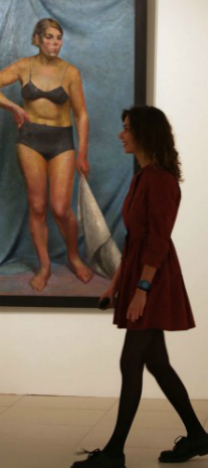
Exhibition “Venera Sovietskaya” focuses on the depiction of women in Soviet art. Source: RG
Plump or muscular, feminine or masculine, posh or austere, classically flattering or downright grotesque, the one thing that Russian art exhibits on beauty seem to agree on is that there is no single definition of beauty in the country’s modern-day society.
Exhibitions exploring and, at times, tearing apart perceived ideas of physical beauty are currently tucked away in several Moscow galleries.
Two of note include “Venera Sovietskaya” (Soviet Venus) at the Worker and Collective Farm Woman exhibition centre and the recently ended “BOYS” at the ZoomLab Studio. The exhibits explore female and male beauty, respectively.
“Venera Sovietskaya” focuses on the depiction of women in Soviet art, both in sculpture and in painting. One of the more obvious parallels to draw from these “Venuses in shirts,” as they are described by the gallery, is with the American cultural icon “Rosie the Riveter.”
Rosie and her Soviet counterparts were similarly encouraged to assume some of the more traditionally masculine roles. However, one of the more notable differences between the American wartime worker and her Russian sisters is how little of the feminine sexuality the Soviet women have retained. While Rosie kept on her makeup and even had a cheeky glint, the Soviet female icon almost disappeared into her boiler suit.
Some art experts have also attempted to draw shape-based parallels between the Soviet women and their pre-revolutionary predecessors, such as Boris Kustodiyev’s bright portraits of “Kupchikha”(The Merchant’s Wife) and “Krasavitsa” (Beauty). Academics have even said in the past that Russia has a national penchant for larger bodies, which has endured despite the country’s gradual exposure to the Western ideas of ideal body shape.
However, the post-revolutionary woman assumed her shape through inherent strength and hard manual labour. Defined muscle tone was clearly discernible. Conversely, the women in Kustodiyev’s portraits are sedentary, surrounded by fruit and fine foods, and taking on the cushiony appearance of the mattresses upon which they are reclining or the roundness of the grapes they are eating. Wealth and luxury were clearly assets to the beauty of the pre-revolutionary woman, whereas for the post-revolutionary woman they were shunned.
The concept of male beauty in Russia is also changing, as shown by Sasha Guseynova’s “BOYS” exhibit, which strays heavily from the traditional understanding of male beauty. It is possible that the absorption of ideas from the West can be held at least partially responsible for this.
Guseynova, who has so far forged her path through photographing mainly women, captured many of her “BOYS” on film in a more typically female fashion, too. She said that the perceived beauty in modern art and fashion is in conflict with popular Russian ideals of male beauty.
“National consciousness is something that was formed over decades. It says that a man must be brutal,” Guseynova said. “Now fashion dictates completely different things, and our grandparents wonder why boys are like girls, who wear things such as pink socks and colourful trousers. That’s a conflict of fashion and the people’s consciousness. Just try to convince them that it is OK and that you’re not gay. It’s crazy for them.”
Guseynova’s pictures keep an element of the traditional male brutality, but with a twist. Guns and bullets are used by models whose capacity to inflict actual damage seems questionable, and the adoption of such accessories by introspective youths seems tinged with irony.
Some of Guseynova’s models in the more dreamy portraits are very willowy, but most retain their more classical male features, such as a strong jaw, sharp cheekbones and a muscular body. However, the homoeroticism inherent in some is also undeniable, with one shirtless male holding a gun against the forehead of his mirror image in intense rainbow lighting.
When questioned about how long men with more effeminate features have been prominent in Russian culture, Guseynova said that from time immemorial men have dressed as women, such as in the theatre, yet this history does not make the modern-day femininity of men any more acceptable to Russian traditionalists.
“Fashion changes and because of this, the idea of beauty turns on its head every season,” she said. “The distortion is not always successful. People in Russia will not be welcoming painted guys in heels for a long time.”
First published in the Moscow Times.
All rights reserved by Rossiyskaya Gazeta.
Subscribe
to our newsletter!
Get the week's best stories straight to your inbox